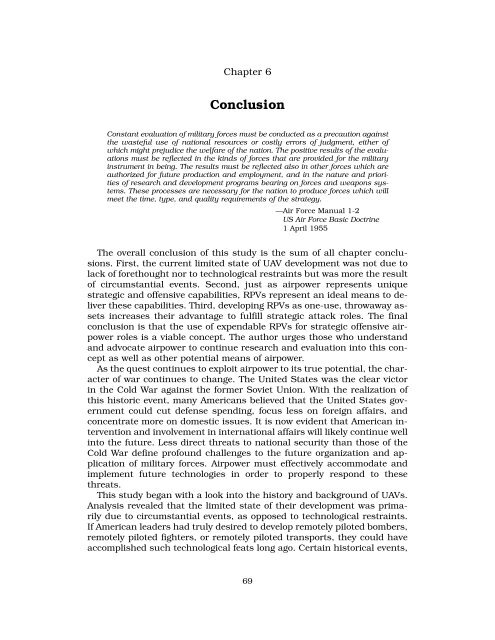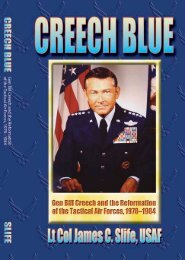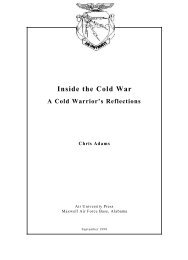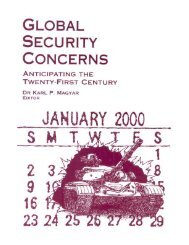Expendable Remotely Piloted Vehicles for Strategic Offensive ...
Expendable Remotely Piloted Vehicles for Strategic Offensive ...
Expendable Remotely Piloted Vehicles for Strategic Offensive ...
Create successful ePaper yourself
Turn your PDF publications into a flip-book with our unique Google optimized e-Paper software.
Chapter 6ConclusionConstant evaluation of military <strong>for</strong>ces must be conducted as a precaution againstthe wasteful use of national resources or costly errors of judgment, either ofwhich might prejudice the welfare of the nation. The positive results of the evaluationsmust be reflected in the kinds of <strong>for</strong>ces that are provided <strong>for</strong> the militaryinstrument in being. The results must be reflected also in other <strong>for</strong>ces which areauthorized <strong>for</strong> future production and employment, and in the nature and prioritiesof research and development programs bearing on <strong>for</strong>ces and weapons systems.These processes are necessary <strong>for</strong> the nation to produce <strong>for</strong>ces which willmeet the time, type, and quality requirements of the strategy.—Air Force Manual 1-2US Air Force Basic Doctrine1 April 1955The overall conclusion of this study is the sum of all chapter conclusions.First, the current limited state of UAV development was not due tolack of <strong>for</strong>ethought nor to technological restraints but was more the resultof circumstantial events. Second, just as airpower represents uniquestrategic and offensive capabilities, RPVs represent an ideal means to deliverthese capabilities. Third, developing RPVs as one-use, throwaway assetsincreases their advantage to fulfill strategic attack roles. The finalconclusion is that the use of expendable RPVs <strong>for</strong> strategic offensive airpowerroles is a viable concept. The author urges those who understandand advocate airpower to continue research and evaluation into this conceptas well as other potential means of airpower.As the quest continues to exploit airpower to its true potential, the characterof war continues to change. The United States was the clear victorin the Cold War against the <strong>for</strong>mer Soviet Union. With the realization ofthis historic event, many Americans believed that the United States governmentcould cut defense spending, focus less on <strong>for</strong>eign affairs, andconcentrate more on domestic issues. It is now evident that American interventionand involvement in international affairs will likely continue wellinto the future. Less direct threats to national security than those of theCold War define profound challenges to the future organization and applicationof military <strong>for</strong>ces. Airpower must effectively accommodate andimplement future technologies in order to properly respond to thesethreats.This study began with a look into the history and background of UAVs.Analysis revealed that the limited state of their development was primarilydue to circumstantial events, as opposed to technological restraints.If American leaders had truly desired to develop remotely piloted bombers,remotely piloted fighters, or remotely piloted transports, they could haveaccomplished such technological feats long ago. Certain historical events,69






